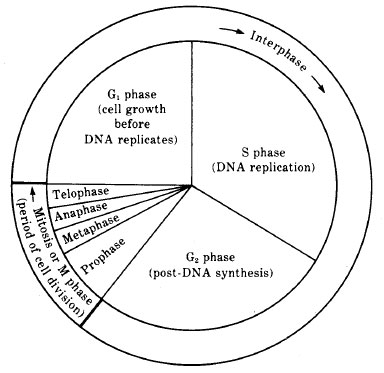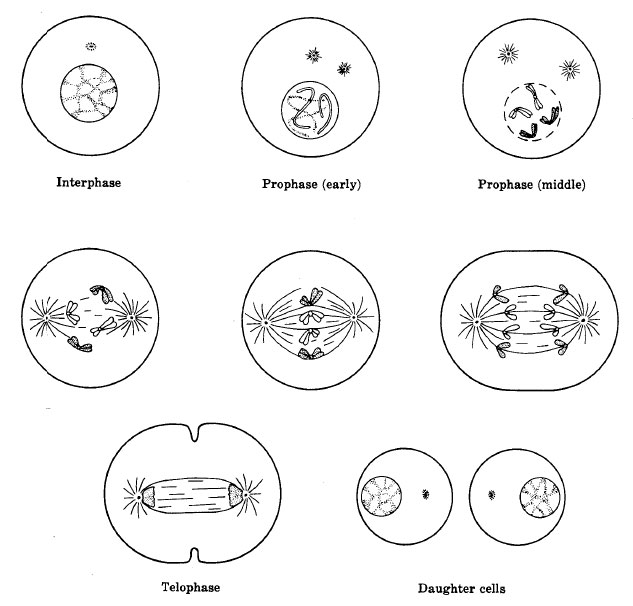Reproduction
Most cells reproduce asexually, without exchanging or acquiring new hereditary information. Bacteria reproduce almost exclusively in this fashion in a process called binary fission, during which the bacterium grows, duplicates its hereditary information, segregates the duplicated chromosome, and divides the cytoplasm. Most cells that form the bodies of multicellular eukaryotes are also produced asexually in a process termed mitosis. During mitotic division, the cells grow, duplicate their genomes, separate their duplicated chromosome sets into nuclei at the opposite poles of the cell, and divide the cytoplasm to form progeny cells.The eukaryotic cell cycle contains four major phases (Figure 1-4). The S phase is when DNA synthesis occurs to replicate the chromosomes by creating identical sister chromatids. The period between S phase and the beginning of mitosis (M phase) is a gap, or growth period, designated G2 phase. Another gap or growth period called the G1 phase, occurs between the M and S phases to complete the cycle.
Mitosis consists of four consecutive phases: prophase, metaphase, anaphase, and telophase (Figure 1-5). During prophase, each chromosome shortens and thickens by supercoiling on itself again and again.
The nuclear membrane dissolves, and a spindle of microtubules forms from one pole of the cell to the other. During metaphase, the chromosomes line up in the center of the spindle. At anaphase, the two chromatids of each replicated chromosome are pulled to opposite poles by depolymerization of the microtubules in the spindle apparatus that are attached to the centromeres. These former sister chromatids are now considered to be new chromosomes. Division of the cytoplasm (cytokinesis) begins in telophase, as the chromosomes unwind and new nuclear membranes form to enclose the sets of chromosomes at each pole of the cell. When mitosis is completed, two progeny cells contain identical sets of chromosomes.
The somatic cells of most plants and animals are diploid, meaning they have two sets of homologous chromosomes. One set is derived from each parent through the gametes that produced the zygote from which the organism developed. The process of meiosis reduces the chromosome number from diploid to haploid in gametes, or sex cells; thus, each parent contributes an equal number of chromosomes to their offspring.
The predominant form of reproduction in most multicellular eukaryotes is sexual. At sexual maturity, some diploid germ line cells become specialized to undergo meiosis and form haploid gametes. Meiosis can be visualized as two highly modified cell cycles, back to back (see Figure 1-6). A complete meiotic cycle involves one initial DNA replication and two cytoplasmic divisions, yielding four haploid products, none of which are genetically identical. The two cycles are labeled meiosis I and II, each of which has its own prophase, metaphase, anaphase, and telophase.
The major events of these phases mirrors the events during mitosis. However, during prophase I of meiosis, homologous chromosomes pair up in a process called synapsis. A synapsed pair of chromosomes contains four chromatids. Each chromosome usually has one or more regions in which two of the four chromatids break at corresponding sites and reunite with one another, a process called crossing over, which increases genetic variability. During anaphase I, the homologous chromosomes are separated, yielding two haploid cells at the completion of the first stage of meiosis. During anaphase II, sister chromatids are separated, as they are during mitotic anaphase. The end result is four genetically different haploid cells.
Notes
Meiosis I is reductional division, since the number of chromosomes is reduced; meiosis II is equational division.







